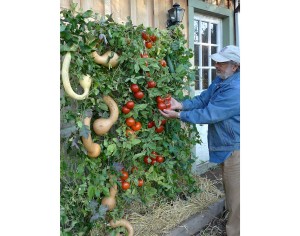Planting a vegetable garden is good for your wallet and for your health! That $2 tomato plant can yield up to 10 pounds of tomatoes a season.
And, planting a garden relieves stress! Getting your hands deep in dirt and being in nature makes you forget about life’s daily stressors! A little Vitamin D from the sun goes a long way in improving your health and the sunlight helps improve your mood, too.
Gardening is also a great activity to do with family or friends. And, there’s nothing tastier than a fresh handpicked tomato out of your garden. Knowing that you helped the plant grow by caring for it makes the whole experience even more rewarding, too.
Here are five steps you need to get your vegetable garden growing in no time:
1. Plan Ahead
Think about what vegetables and/or even fruit you would like to grow. Then, think about what you and your family would eat. This means, don’t plant a lot of radishes when you’ve never even tasted them before. Vegetables like corn, carrots, and radishes produce once while vegetables like peppers and tomatoes produce again and again over the course of one season.
2. Space
Remember to factor in how much space you have and what you can realistically fit in your garden. Many first time gardeners get too excited and end up planting too much crop, then ending up wasting food.
If you are planting in pots, you can easily envision how much room you’ll need. Or, you could grow vertically using a Garden Trellis. Fifthroom.com’s Skyscraper Garden Trellis allows you to grow plants against a wall or as a free-standing unit.
Each unit provides a 4-foot wide by 6-foot high re-useable structure on which to grow vegetables or vining flowers. Although it takes up only 4 square feet of growing space, it will produce more vegetation than a 24 square foot plot!
3. Make Sure You Have Sun, Soil, & Water
Without these, your garden won’t be successful! If you have sun, soil and water, you are bound to produce a successful vegetable garden — even if you don’t have a green thumb!
Your veggies need at least 6-8 hours of direct sunlight. If they don’t get the right amount, you won’t have as much production and they will be more susceptible to little critters and diseases!
Your plants will need plenty of water, too. When it’s dry outside, make sure to water them. When deciding where to start your vegetable garden, plant close to a water source.
And, you’ll need good soil that’s moist, well-drained and rich in organic matter (like compost).
4. Row Cropping vs. Intensive Cropping
When you’re growing a large vegetable garden, use row cropping, the method of planting your veggies single file in rows with walkways in between each row. Allow 18 inches of room between each row so you have room to work!
Another method of planting you can use is intensive cropping, which allows you to design your vegetable garden and space crops closely. This is much more aesthetically pleasing than row cropping.
This type of cropping reduces the amount of space needed for a path. Intensive cropping is the most efficient and effective way to garden. Learn more about how you can incorporate intensive cropping here.
These four steps will at least get your vegetable garden started! And, once you are done planting, head over to Fifthroom.com, where we have beautiful garden structures, outdoor furniture and decor to enhance your garden and overall outdoor living lifestyle!




Udaya
This very useful for improving cultivation knowledge
Udaya
Vegetables cultivation